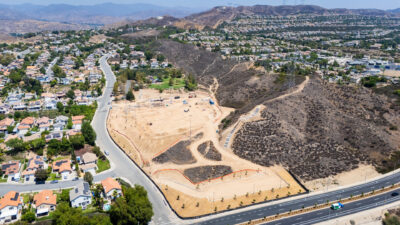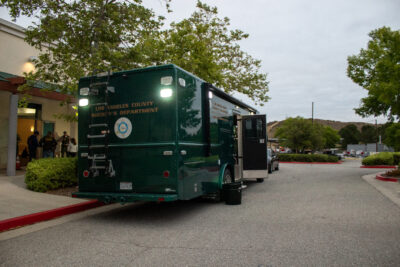Compiled from news service reports
A bilateral meeting in Alaska between U.S. President Donald Trump and Russian President Vladimir Putin ended after two and a half hours, culminating in a roughly 10-minute joint press conference that was warm in tone but furnished few details on any deal.
The two leaders emerged from their airplanes at the same time, greeting each other at the intersection of their red carpets on the tarmac. As they shook hands, American military jets flew overhead, underscoring the significance of a meeting at Joint Base Elmendorf-Richardson in a state that is right next door to Russia.
During the talks, Trump was accompanied by Secretary of State Marco Rubio and special envoy Steve Witkoff. Putin was accompanied by Foreign Minister Sergei Lavrov, and his assistant for foreign affairs, Yuri Ushakov.
In his remarks, Putin stressed the common history between the two countries, including during World War II.
Putin said the United States and Russia had reached an agreement, adding that he hoped Ukraine and European countries would not undermine that progress. He did not delve into any specifics on the agreement.
The Russian leader said Trump “understands that Russia has its own national interests,” saying he was confident an end to the Ukraine conflict would eventually come. He did not say whether a cease-fire had been reached.
Putin said there were ongoing discussions to “bring back business relations between Russia and the U.S.,” which have been limited by sanctions. He said trade between the countries has improved under Trump.
Trump said the talks made “some headway,” but “we didn’t get there.”
“But we have a very good chance of getting there,” the U.S. president added.
Trump said that “there’s no deal until there’s a deal,” adding he would speak with NATO and Ukraine President Volodymyr Zelenskyy about the meeting.
Trump said he and Putin agreed on most points except one, which “is probably the most significant.” He didn’t specify what it was.
Putin suggested their next meeting should be in Moscow. Trump did not immediately agree but said it was a possibility.
Putin: There Would Have Been No War If Trump Had Been President
During the joint press conference after the summit, Putin said he agreed with Trump that if the latter had been leading the United States in 2022, there would have been no war between Russia and Ukraine.
“I can confirm that,” Putin said.
The Russian leader told reporters that he had tried to persuade the Biden administration to avoid reaching “the point of no return when it would come to hostilities” in 2022, just before Russia invaded its neighbor.
Tensions mounted in early 2022 over Ukraine’s desire to join NATO. The United States would not foreclose the possibility of admitting the country to the defense alliance, which Russia sees as a threat.
Putin Announces ‘Agreement’ With Trump
Putin announced during the joint press conference with Trump that the two nations had come to broad agreement on several issues, including the security of Ukraine.
Putin said, “We agree with President Trump, as he has said today, naturally, that the security of Ukraine should be ensured as well.”
Putin said that Russia was “naturally … prepared to welcome” an agreement that will benefit both nations.
“I like to hope that the agreement we have reached will bring us closer to that goal and pave the path toward peace in Europe,” he said.
Zelenskyy: No Indication Moscow Is Looking to End War
Hours before the Trump – Putin summit, Zelenskyy said on Telegram that Russia had launched a series of attacks on Ukraine before the scheduled talks. However, the new assault in the east failed, he said.
“On the day of the negotiations, they also kill people. And that says a lot,” Zelenskyy said. “The war continues. It continues precisely because there is no order, nor any indication that Moscow is preparing to end this war.”
The Ukrainian president said he is receiving reports from various regions throughout the country following the Russian strikes.
In Sumy, Russia hit the central market, and in the Dnipro region, it struck cities and businesses, he said. The Zaporizhzhia, Kherson, and Donetsk regions were hit with “deliberate Russian strikes,” Zelenskyy said.
He referred to this as an attempt by Moscow to “demonstrate force” ahead of negotiations with Trump in Alaska. Russia has not yet commented on the attacks.
Ukraine is counting on the United States and necessary security guarantees, and a meeting between all three nations is needed, Zelenskyy added.
Russian Military Thrust Tests Key Ukrainian Frontline
This week, the world’s attention was focused largely on the landmark summit between Trump and Putin. But preparations for the event have coincided with significant military developments in Donetsk, where Russian forces staged a sudden thrust several miles into Ukrainian-held territory.
While Ukrainian officials say the situation has stabilized, the Russian advance has prompted fears of a potential collapse of Kyiv’s defense lines.
“The front hasn’t collapsed, but the risk is high,” said Abdullah Agar, a prominent Turkish military analyst and former Special Forces officer.
“A breakthrough has been prevented for now, but the [Ukrainian] lines are under extreme strain,” he said.
British defense analyst Tim Ripley said it was “too soon to say” whether Ukraine’s defense line was buckling under the pressure.
But recent developments suggest a “growing trend of increasing porousness along the [Ukrainian] frontline,” he said.
“The Russians aren’t using mass tank or vehicle attacks,” Ripley said. “They’re sending small groups of soldiers to dodge past Ukrainian positions. The Ukrainians, fearing they’ll be trapped in their trenches, just withdraw — they are unhinging defensive positions.”
On Tuesday, Zelenskyy confirmed that Russian forces had advanced several miles toward the town of Dobropillia, which sits some 14 miles north of the town of Pokrovsk.
Of enormous strategic importance, Pokrovsk is a vital Ukrainian transit hub, the capture of which has long been a key Russian objective.
“Losing Pokrovsk would make defending key cities like Sloviansk and Kramatorsk much harder,” Agar said. “If Russia cuts the supply route from Dobropillia to Kramatorsk, Ukraine’s defense would face severe problems in terms of morale, resources, reinforcements, and evacuations, creating serious operational setbacks.”
According to Ripley, there are “four encirclement operations underway along the Donetsk-Luhansk frontline; four bulges the Russians are trying to squeeze.”
“They’re putting quite a lot of resources into it, and they seem to be having some success,” said Ripley.
Nathan Worcester, Joseph Lord, Adam Morrow and Jacob Burg contributed to this report.








